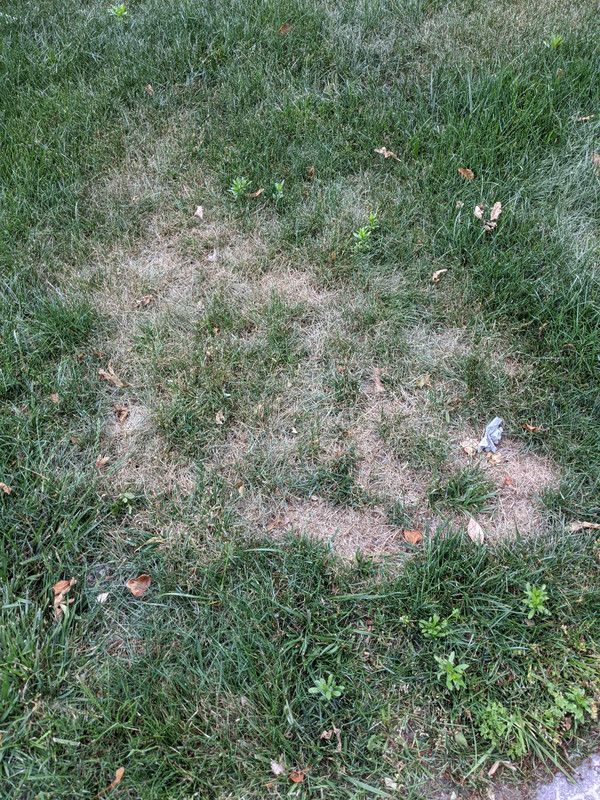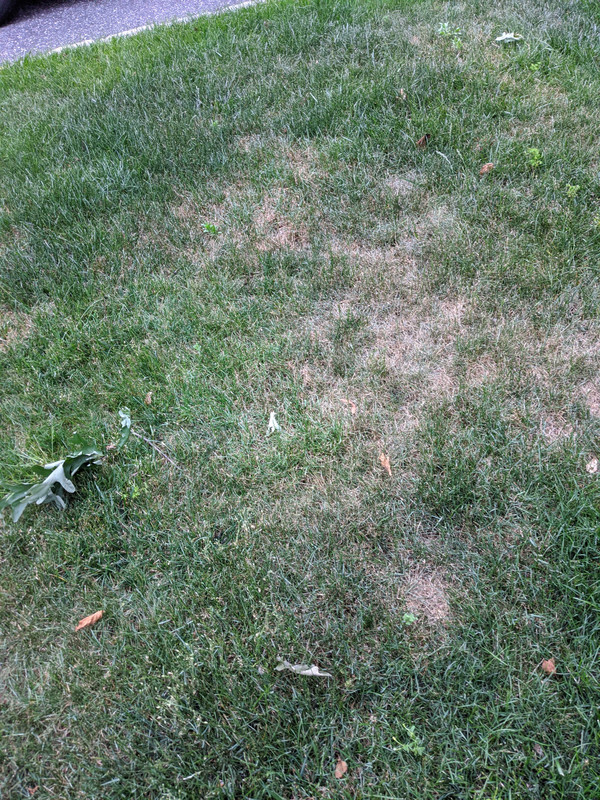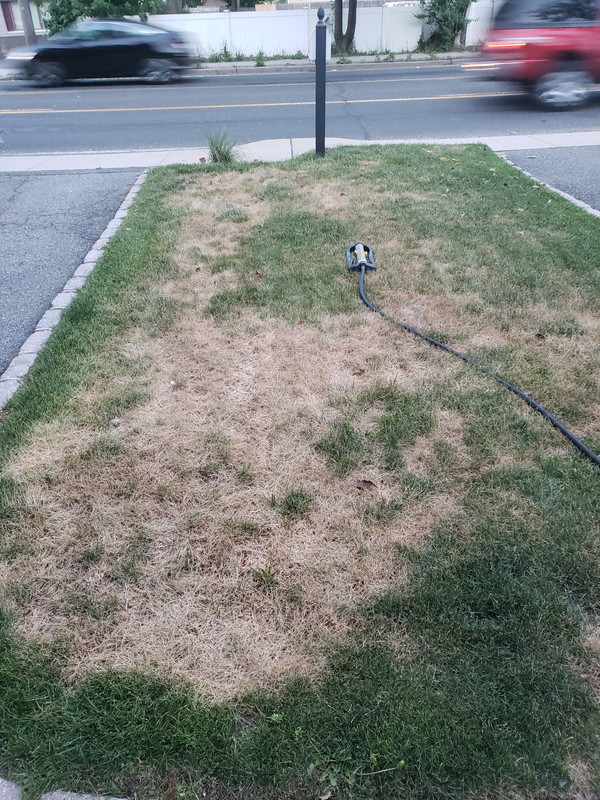Hello all. Each of the last few years I fertilize/water my lawn in April/May and it becomes really green and nice for a few weeks then starts to get brown spots. Watering doesn't help. Any idea why? Thanks a lot,

mstrlucky74
Lawn turns brown a few weeks after fert.
mstrlucky74
Discussion starter
449 posts
·
Joined 2020
- Add to quote Only show this user
Hello all. Each of the last few years I fertilize/water my lawn in April/May and it becomes really green and nice for a few weeks then starts to get brown spots. Watering doesn't help. Any idea why? Thanks a lot,
2,984 posts
·
Joined 2017
@mstrlucky74, Welcome to TLF! I put your post here in the cool season forum for site organization. Cheers!
2,783 posts
·
Joined 2018
Photos will definitely help, along with a few more details of what fertilizer you were putting down, the amount, and how often. Info on watering and mowing practices will help add to the picture, too.
324 posts
·
Joined 2019
By few weeks you mean summer dormancy? If fertilizer killed your lawn, it wouldn't green up back again, and you would either have to reseed or wait for it to spread if you have KBG.
mstrlucky74
Discussion starter
449 posts
·
Joined 2020
2,783 posts
·
Joined 2018
Were these taken recently, or last year after it browned out? Without more info, I can only offer a few guesses:
1. Rocks or debris under the area-try the screwdriver test.
2. Poa Annua (Annual Bluegrass) die off or Poa Trivialis (Rough Bluegrass) summer dormancy. Does it seem to greenup again in the fall, or not really until the following year?
3. Fungus
1. Rocks or debris under the area-try the screwdriver test.
2. Poa Annua (Annual Bluegrass) die off or Poa Trivialis (Rough Bluegrass) summer dormancy. Does it seem to greenup again in the fall, or not really until the following year?
3. Fungus
mstrlucky74
Discussion starter
449 posts
·
Joined 2020
These were taken about a week ago. Like I said I put fertilizer on it about a month ago and it turned very green for a week or two and looked great but then developed these brown spots The same thing happened last yearChris LI said:Were these taken recently, or last year after it browned out? Without more info, I can only offer a few guesses:
1. Rocks or debris under the area-try the screwdriver test.
2. Poa Annua (Annual Bluegrass) die off or Poa Trivialis (Rough Bluegrass) summer dormancy. Does it seem to greenup again in the fall, or not really until the following year?
3. Fungus
2,783 posts
·
Joined 2018
Have you been watering? It's been exceptionally dry. Patches of Poa A in my backyard crapped out due to the dryness. I let Mother Nature water in the spring, and I only supplement when necessary. When I do water, I water deeply (i.e. references in my journal to "pounding it with water". This helps encourage the roots to dive deeper into the soil to pull moisture. Do you recall if the grass that turned brown was lighter than the rest of your grass? If we can determine if it is Poa A crapping out on you, then fall PreM is the solution. If you see that the brown grass starts to greenup after the summer, than it's probably Poa T, which is much more difficult to combat.
If you notice other areas beginning to brown, take photos over a few days, to help ID the issue. If you notice spots, blotches, lesions, etc., it's a fugus issue. Since it's been very dry lately, so I think it's less likely a disease issue.
Did you do the screwdriver test to look for debris or compaction?
If you notice other areas beginning to brown, take photos over a few days, to help ID the issue. If you notice spots, blotches, lesions, etc., it's a fugus issue. Since it's been very dry lately, so I think it's less likely a disease issue.
Did you do the screwdriver test to look for debris or compaction?
mstrlucky74
Discussion starter
449 posts
·
Joined 2020
I'm not sure if it greens up in the fall...I actually think so. ThanksChris LI said:Were these taken recently, or last year after it browned out? Without more info, I can only offer a few guesses:
1. Rocks or debris under the area-try the screwdriver test.
2. Poa Annua (Annual Bluegrass) die off or Poa Trivialis (Rough Bluegrass) summer dormancy. Does it seem to greenup again in the fall, or not really until the following year?
3. Fungus
mstrlucky74
Discussion starter
449 posts
·
Joined 2020
What is poa a and t? What's the screwdriver test? I don't recall if those brown spots were light than the rest when all green. I don't think so but maybe . Maybe since it's such a small area(15'x10') I should just rip it all up and plant new seed or sod. Thanks for the help.Chris LI said:Have you been watering? It's been exceptionally dry. Patches of Poa A in my backyard crapped out due to the dryness. I let Mother Nature water in the spring, and I only supplement when necessary. When I do water, I water deeply (i.e. references in my journal to "pounding it with water". This helps encourage the roots to dive deeper into the soil to pull moisture. Do you recall if the grass that turned brown was lighter than the rest of your grass? If we can determine if it is Poa A crapping out on you, then fall PreM is the solution. If you see that the brown grass starts to greenup after the summer, than it's probably Poa T, which is much more difficult to combat.
If you notice other areas beginning to brown, take photos over a few days, to help ID the issue. If you notice spots, blotches, lesions, etc., it's a fugus issue. Since it's been very dry lately, so I think it's less likely a disease issue.
Did you do the screwdriver test to look for debris or compaction?
2,783 posts
·
Joined 2018
Poa Annua is a grassy weed (Annual Bluegrass). It is lime green in color, so it stands out in the lawn. It is much easier to deal with by preventing it with a Preemergent herbicide towards the end of the summer, because it germinates in the fall. Since it is an annual plant, it typically dies off each year (with some exceptions). It does not take heat/drought well, so it tends to crap out in the summer, hence the comment about some in my backyard. Tenacity is an herbicide that can be used to combat Poa A, but that's another discussion.
Poa Trivialis is also a grassy weed (Roughstalk Bluegrass). It's also lighter green and grows faster than most turfgrass. It's nastier to deal with, as it's a perennial plant. It turns brown in the summer like Poa A, but only goes into dormancy, and does not die off. It comes back in the fall when temperatures drop. It's very difficult to eradicate. The best option is spot spraying Roundup in the spring when it is actively growing, as long as you get a proper ID.
Both Poa A and Poa T are in the same family as Kentucky Bluegrass (Poa Pratensis), so that makes it more difficult to treat with herbicides than broadleaf weeds.
The screwdriver test is simply pushing a screwdriver down to see how far it will go. If you can't push it in more than an inch or two, you have compaction issues, with possibly large debris underneath. This is where I would start in your case. If you can't push the screwdriver in, make sure the area is moist. You may need to lightly water for a few hours to gently soak the area and try again the next day. Some guys have found hidden boulders under their lawns. If the roots have no where to go, they will get roasted. If you plop sod down over the same condition, you will get the same results.
Please read the Cool Season Guide, as it has this and a lot more great info. Also, if you create a journal, it will help track progress, as you will have reference points, especially if you post photos. Good luck!
Poa Trivialis is also a grassy weed (Roughstalk Bluegrass). It's also lighter green and grows faster than most turfgrass. It's nastier to deal with, as it's a perennial plant. It turns brown in the summer like Poa A, but only goes into dormancy, and does not die off. It comes back in the fall when temperatures drop. It's very difficult to eradicate. The best option is spot spraying Roundup in the spring when it is actively growing, as long as you get a proper ID.
Both Poa A and Poa T are in the same family as Kentucky Bluegrass (Poa Pratensis), so that makes it more difficult to treat with herbicides than broadleaf weeds.
The screwdriver test is simply pushing a screwdriver down to see how far it will go. If you can't push it in more than an inch or two, you have compaction issues, with possibly large debris underneath. This is where I would start in your case. If you can't push the screwdriver in, make sure the area is moist. You may need to lightly water for a few hours to gently soak the area and try again the next day. Some guys have found hidden boulders under their lawns. If the roots have no where to go, they will get roasted. If you plop sod down over the same condition, you will get the same results.
Please read the Cool Season Guide, as it has this and a lot more great info. Also, if you create a journal, it will help track progress, as you will have reference points, especially if you post photos. Good luck!
mstrlucky74
Discussion starter
449 posts
·
Joined 2020
Thanks again all...very much.
What do you think my best approach is at this point? We are selling our house in 2 months.
What do you think my best approach is at this point? We are selling our house in 2 months.
mstrlucky74
Discussion starter
449 posts
·
Joined 2020
Ok, thanksgreencare said:Try watering it three times a week in the early morning.
mstrlucky74
Discussion starter
449 posts
·
Joined 2020
1,395 posts
·
Joined 2017
it looks like you have a fungus. its probably past the point where i would apply a fungicide and just wait until the fall to overseed that area.
17,369 posts
·
Joined 2017
Check for grubs. That doesnt look good.
If you are selling in 2 months, getting a couple of rolls of sod might be good quick recovery.
If you are selling in 2 months, getting a couple of rolls of sod might be good quick recovery.
mstrlucky74
Discussion starter
449 posts
·
Joined 2020
Thanks all. Can I lay sod now or am I better to wait until end of August?
Also, I'll probably lay all new sod. How can I make sure the dirt/soil under is in good condition to accept/grow new grass? Tests? Thanks again.
Also, I'll probably lay all new sod. How can I make sure the dirt/soil under is in good condition to accept/grow new grass? Tests? Thanks again.
-
?
-
?
-
?
-
?
-
?
-
?
-
?
-
?
-
?
-
?
-
?
-
?
-
?
-
?
-
?
-
?
-
?
-
?
-
?
-
?
- posts
- 664K
- members
- 43K
- Since
- 2017
A forum community dedicated to lawn care, landscaping do it yourselfers, and enthusiasts. Come join the discussion to learn about industry equipment, tools, lawn care, lawn maintenance, classifieds, troubleshooting, and more!






